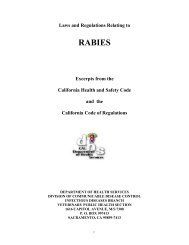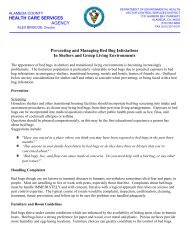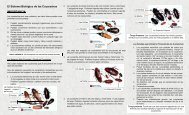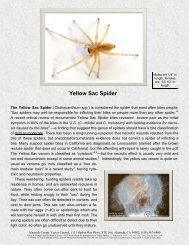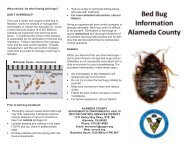Pigeon Brochure - Vector Control Services - Alameda County
Pigeon Brochure - Vector Control Services - Alameda County
Pigeon Brochure - Vector Control Services - Alameda County
You also want an ePaper? Increase the reach of your titles
YUMPU automatically turns print PDFs into web optimized ePapers that Google loves.
achieve positive results. In a city of any size, it is<br />
impossible for all the official agencies that touch<br />
upon the general sanitary condition of the community<br />
to exercise complete day-to-day control of<br />
the environment so that no food and nesting<br />
materials are available to pigeons. In view of the<br />
fact that pigeons are general feeders, nest in many<br />
kinds of situations, and are very prolific, it is<br />
evident that a good pigeon reduction program must<br />
include every activity listed in the "permanent<br />
control" section. Food control measures and<br />
exclusion of the birds, combined with such<br />
temporary, secondary means of reduction as nest<br />
elimination and trapping as needed may be<br />
necessary.<br />
Since voluntary compliance may be difficult to<br />
attain in this sort of activity, and most of the birds<br />
appear to be ownerless, legislation may be needed<br />
to help accomplish the needed reduction in the<br />
pigeon population.<br />
<strong>Alameda</strong> <strong>County</strong> <strong>Vector</strong> <strong>Control</strong><br />
<strong>Services</strong> District<br />
1131 Harbor Bay Parkway<br />
suite 166<br />
<strong>Alameda</strong>, CA 94502<br />
PIGEON<br />
CONTROL<br />
The common pigeon Columba livia<br />
(the Rock Dove) is present in a wild or<br />
ownerless state in many cities. Some<br />
cities have areas, in which the<br />
population level is high, and there are<br />
also large areas in which the level is<br />
low, but the birds are still noticeable.<br />
This bird is a scavenger, much like the<br />
Norway rat. Reasons for the need for<br />
pigeon control, biology of the bird, and<br />
methods of control and their limitations<br />
are given within.<br />
510-567-6800<br />
ACVCSD Rev. 04/13/2001 Pitcher/Scott/Wilson
NEED FOR CONTROL<br />
Diseases may be carried by these birds and<br />
transmitted to humans. Ornithosis (or psittacosis—<br />
commonly called parrot-fever) is found in pigeons,<br />
the population of which may serve as a vast<br />
reservoir for the organism. Cryptococcosis is<br />
another disease caused by a fungus found in<br />
pigeon droppings that may infect humans.<br />
Dermatitis can be caused by pigeon mites that<br />
often migrate from the nests and bite people.<br />
preventive exclusion in new construction, as well<br />
as buildings being remodeled must be included.<br />
Some cities have laws forbidding the keeping of<br />
farm animals within municipal boundaries. The<br />
laws may also restrict the keeping of pigeons,<br />
although homing and racing pigeons may be<br />
allowed.<br />
The ordinance might be based instead on a<br />
prohibition against pigeons flying at large, except<br />
banded pigeons (which may fly only under specific<br />
conditions), with provisions for the pigeons at<br />
large to be taken up and impounded.<br />
Defacement of buildings, vehicles, trees, shrubs,<br />
lawns, benches and fountains in parks, by<br />
excrement occurs where the birds habitually<br />
congregate. The removal of the excrement is an<br />
additional cost of maintenance.<br />
Odors may be produced by droppings, feathers,<br />
and nesting materials.<br />
Flies may develop in large numbers in<br />
accumulated moist manure that is protected from<br />
drying in sheltered roosting and nesting areas.<br />
Noise may be produced by these birds; this<br />
unwanted sound is obnoxious to some people.<br />
EDUCATION OF PUBLIC<br />
The public must be informed of the need for<br />
pigeon control. Emphasis should be on the<br />
reduction of feeding of wild pigeons.<br />
SUMMARY<br />
Good pigeon control depends upon good food<br />
control and firm and persistent activities in<br />
eliminating nesting and roosting places. Both food<br />
and nest control are related to the state of general<br />
sanitation in a community. General sanitation must<br />
be good and must be kept that way in order to<br />
2<br />
11
disposed of in a humane manner.<br />
5. Removal and Destruction of nests and eggs is<br />
useful in reducing the pigeon population. Nests<br />
need to be removed every two weeks. Treatment<br />
may be required for bird mite populations.<br />
6. Chemosterilants: Feeding female birds corn<br />
treated with diazacholestenol dihydrochloride,<br />
marketed as Ornitrol (trademark), results in<br />
temporary sterilization by interfering with embryo<br />
formation in the egg. A ten day feeding interval<br />
will inhibit fertility for about six months. Two<br />
feedings per year are recommended. It must be<br />
done by a certified applicator. If done properly the<br />
birds are not harmed, if done improperly death can<br />
occur.<br />
7. Poisoning or Shooting is not recommended and<br />
is illegal in most cities.<br />
LEGAL RESTRICTIONS<br />
Ordinances controlling feeding of wild pigeons<br />
can be useful in alleviating the pigeon nuisance<br />
problems. Such ordinances might not contain an<br />
outright prohibition of feeding wild pigeons, but<br />
may provide for their being fed at certain<br />
designated, limited locations. If this restricted<br />
feeding is allowed, then clean-up at regular,<br />
specified intervals must be included in order not to<br />
provide food for rats and mice. Provision for<br />
reduction of nesting, roosting space/areas and<br />
Safety of pedestrians may be endangered by<br />
slipping due to the presence of excess bird<br />
droppings on walk-ways.<br />
A hazard to Aircraft may result from large<br />
numbers of pigeons.<br />
BIOLOGY<br />
It is important to know the biology of pigeons in<br />
order to understand the methods of control. The<br />
birds tend to stay together. For roosting, the birds<br />
usually prefer larger, higher buildings, although<br />
small, low buildings may be selected if close to<br />
food. Nests are made of small twigs, pieces of<br />
string, paper, and cloth obtained from any source<br />
possible. The nests are built on roofs, ledges large<br />
enough to accommodate the nest, openings in<br />
buildings, and even drain spouts. <strong>Pigeon</strong>s try to<br />
nest as close as possible to a constant food supply.<br />
A pigeon couple may have two nests.<br />
<strong>Pigeon</strong>s are monogamous, and eight to twelve days<br />
after mating, the female lays one or two eggs. The<br />
male cares for and guards the female. The young<br />
leave the nest between the age of 4 and 6 weeks.<br />
Often, more eggs are laid before these young ever<br />
leave the nest. An adult female pigeon can have<br />
about 15 surviving young a year. These birds have<br />
10<br />
3
a life-span up to 15 years. The breeding cycle is<br />
almost continuous although the number of young<br />
hatching varies somewhat by season. An adult<br />
pigeon consumes about one pound of food per<br />
week. <strong>Pigeon</strong>s can live up to a week without food.<br />
The pigeons preferred food is mainly whole grains<br />
and greens, but the birds will thrive on bread<br />
crumbs, pop corn, and miscellaneous food scraps<br />
(including in open garbage cans and spilled<br />
garbage). <strong>Pigeon</strong>s may fly several hundred miles<br />
during a day, usually returning to the same nesting<br />
spot.<br />
CONTROL MEASURES<br />
It is not possible to eradicate all the pigeons in a<br />
city. It is possible to reduce the population to a<br />
tolerable level. Methods may be used to reduce the<br />
population quickly and directly or slowly and<br />
indirectly. Emphasis should be placed on methods<br />
which will bring about a long-term maximum<br />
population reduction with the least amount of<br />
effort and expense.<br />
Many different methods have been used to control<br />
pigeons. The measures may be divided into two<br />
categories: permanent control and temporary<br />
control. These methods will be discussed; legal<br />
and other approaches will also be discussed. It<br />
should be noted that some of the same conditions<br />
which allow the production of large pigeon<br />
4<br />
of adhesiveness. Physically these are semi- solids<br />
(jelly entanglements, adhesives) or liquids (sprays).<br />
Entanglements may be applied relatively easy to<br />
smooth, regular, easily accessible spots. These<br />
materials may be applied by means of caulking guns<br />
to favorite roosting spots. Two or three bands must<br />
be applied to ledges and all space used by birds must<br />
be treated. Numerous small bands of material are<br />
more effective than one wide band. Entanglements<br />
have to be checked and renewed regularly.<br />
Sprays may be used on flat areas; strips totaling 25 -<br />
30% of the area are needed. Trees may be sprayed<br />
with a water-based spray. These chemicals are<br />
available from wholesale suppliers only and may be<br />
applied by pest control firms.<br />
Naphthalene flakes are registered as a repellent.<br />
They may be applied in enclosed areas such as attics<br />
or between walls. However, avoid breathing of the<br />
vapor which is toxic (Always follow product label<br />
instructions).<br />
3. Electric shocking equipment in the form of<br />
fencing, may be used; the low voltage gives a mild<br />
shock. This is an effective device, expensive, but<br />
long-lived if installed and maintained properly.<br />
4. Trapping is a measure that can be effective if<br />
carried out with persistence, but it is slow and<br />
tedious. Traps should be placed in areas where birds<br />
feed and will not be molested. The traps should be<br />
well supplied with feed of the type the birds are<br />
already eating. A good bait is one made of one part<br />
wheat and five parts cracked corn. Corn has been<br />
found to be an excellent bait also. A little bait is<br />
scattered outside the trap to act as an attractant.<br />
Drinking water should be put in the trap. Trapped<br />
birds should be removed at least twice a week and<br />
9
B. Temporary <strong>Control</strong> should only be used to<br />
supplement permanent control measures.<br />
Temporary methods are less effective and when<br />
used on a large scale are costly. Several types may<br />
be used at a time. The use of some of these<br />
methods may cause an adverse public reaction.<br />
Some of these methods merely make the birds<br />
relocate.<br />
l. Frightening Agents: There are two types:<br />
Physical and Chemical<br />
Physical agents such as whirling strips and spirals<br />
of bright cloth or metal are occasionally effective<br />
but usually have little effect. Simulated owls or<br />
other predators give similar results. High<br />
frequency sound (ultrasonic sound inaudible to<br />
humans) has no effect on pigeons.<br />
The Chemical agent 4-Amino pyridine, marketed<br />
as Avitrol (trademark), is classified as a<br />
frightening agent since upon ingestion by birds, it<br />
creates distress behavior in the birds and frightens<br />
other birds away. It is a Restricted Use Pesticide<br />
and therefore can only be used by a certified<br />
applicator. If not used properly it can cause high<br />
mortality in the birds. The proper blend of the<br />
chemical and whole corn attractant can result in<br />
very low bird mortality.<br />
2. Repellents and deterrents have been used to<br />
keep birds from staying in one spot. Some repel<br />
because of an irritating factor and others because<br />
8<br />
populations may allow for the development of a<br />
large rat population.<br />
A. Permanent <strong>Control</strong><br />
l. Food <strong>Control</strong> if accomplished correctly, is the<br />
most practical control method and less costly than<br />
temporary measures. It is a basic means of<br />
population control since it deprives the birds of<br />
material without which they cannot survive.<br />
a. Garbage must be stored in sturdy cans with<br />
tight-fitting covers. Garbage must be handled<br />
carefully and not be spilled on the ground at any<br />
time. Uneaten food for domestic pets and other<br />
backyard animals must be removed after feeding<br />
time or protected from pigeons. Grain mills and<br />
animal feed lots attract pigeons; spillage must be<br />
controlled and the birds kept out.<br />
b. Food purposely provided by the public in parks,<br />
backyards or other areas is one of the major<br />
sources of sustenance for birds in cities.<br />
Discouraging this practice is a difficult but<br />
absolutely necessary aspect of pigeon control. The<br />
pigeon population will vary directly in proportion<br />
to the amount of food available to them. <strong>Pigeon</strong>s<br />
can survive very well in the wild away from cities<br />
without humans feeding them.<br />
c. Food control at nature centers, parks, and zoos<br />
are especially difficult. The amount of food put out<br />
for animals at zoos must be strictly rationed and<br />
protected.<br />
5
Some structures may need to be pigeon-proofed.<br />
2. Exclusion is the modification of building or<br />
other structures in such a way that the birds cannot<br />
enter, roost, or nest in or on them. It may be<br />
divided into interior and exterior exclusion.<br />
a. Interior exclusion involves blocking or<br />
modifying access to indoor roosting, feeding, and<br />
nesting places. Openings may be blocked with<br />
wood, metal, glass, masonry, or hardware cloth.<br />
The last material is used when ventilation is<br />
involved. <strong>Pigeon</strong>s are excluded by 1 1/2" mesh and<br />
rats by 1/2" mesh hardware cloth. Seventeen<br />
gauge, galvanized material is preferred. Materials<br />
should be installed in a manner that results in no<br />
outside ledges or projections being provided for<br />
birds to roost.<br />
b. Exterior exclusion is the removal, blocking, or<br />
modifying of all surfaces so that pigeons cannot<br />
nest or roost upon them. Where ledges are not<br />
wide (6" or less) light metal, such as sheet<br />
aluminum, can be installed at a 45 degree angle to<br />
present a slope on which the bird cannot rest or<br />
nest. Hardware cloth can also be used. End<br />
sections of this flashing must be closed in order to<br />
keep birds out.<br />
Projecting signs, decorations, and off-set edges<br />
should be removed whenever possible. If removal<br />
is not possible, boxing in exposed areas or<br />
complete remodeling may be needed. Old sheds,<br />
abandoned buildings, junk piles, and the like<br />
should be removed. In some instances, "porcupine<br />
6<br />
wires" may be used. These are flexible, rust-proof<br />
bars or strips on which about 120 needles per<br />
linear foot are set in the form of half-circles. The<br />
strips come with fasteners designed for a particular<br />
surface. The strips may be attached to most types<br />
of surfaces. A similar device uses looped<br />
"wickets". These devices are effective, especially<br />
in limited areas, such as a ledge over a doorway;<br />
they have been used on ledges, ornaments, signs,<br />
dormers, and roof gutters. Installation can be<br />
expensive and difficult.<br />
There are many commercially available pigeon<br />
exclusion systems, as well as companies that<br />
specialize in bird exclusion.<br />
<strong>Pigeon</strong>s may build a nest on "porcupine wire" by<br />
building up a basic protective layer of sticks and<br />
straw. Falling leaves may nullify the effectiveness<br />
of the strips.<br />
Exclusion gives permanent control providing (1)<br />
installation was done properly, (2) unprotected<br />
doors, and windows are not left open, (3) and<br />
repairs and new construction maintain the<br />
exclusion integrity of the structure.<br />
Routine inspection and prompt repair are essential<br />
to effective pigeon exclusion system. Provisions<br />
should be made for effective pigeon exclusion in<br />
new construction and buildings undergoing<br />
remodeling.<br />
7



